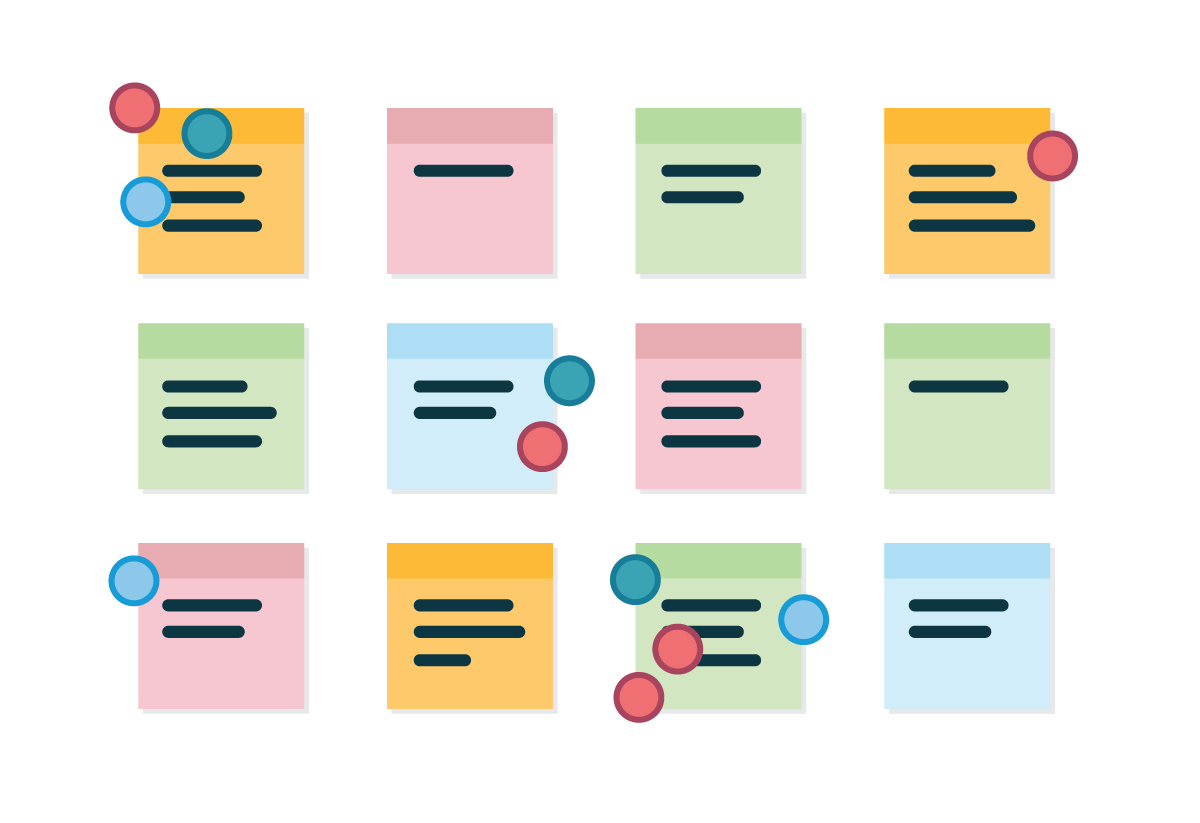Facilitate a Brainstorming Session
Learning Objectives
After completing this unit, you’ll be able to:
- Identify brainstorming rules.
- Describe the dot voting process.
Ready, Set, Brainstorm
When you have your participants and your provocations, you’re ready to run your brainstorm. Whether you do it in person with sticky notes and sharpies or virtually with a tool like Figjam, Miro, Muraly, or Jamboard, it’s a session where people get together to create and share ideas. Make sure to spend a little time at the beginning of your session giving participants context on your project goals and key research insights. But the bulk of your time should be spent exchanging ideas.
Brainstorming is a process most people have experienced, but there are ways to set up your session for success. Follow the brainstorming rules below to ensure a productive and creative session.
Encourage Wild Ideas
Brainstorming is an activity where the primary purpose is to be generative, to collect ideas. Give yourself and your team permission to think big and even record ideas that you know are impossible to build. Your impossible idea may trigger someone else’s related and more feasible idea.
Go for Quantity
There are times in the design process when you and your team should be intentionally divergent and generative, asking yourselves to dig deeper and produce more than the first round of ideas that come to mind. You have to get out the “first blush” ideas before your mind is free to explore other avenues of thought. Aiming for quantity takes the pressure off of hoping for quality.
Defer Judgment
There are other times in the design process where you intentionally judge ideas, analyzing their potential as solutions. There’s a tendency to want to do both at once during a brainstorm, but if you judge too early, you run the risk of reducing the psychological safety of your participants, and may not ever hear their great ideas.
Be Visual
A picture is worth 1,000 words. When you sketch ideas, even poorly, they are more easily understood and digested by others than written words on a sticky note. They can be “read” from a distance, and sometimes someone will misunderstand the sketch in a way that sparks a new idea.
Build on the Ideas of Others
Brainstorms are an opportunity to take advantage of collective thought. No one owns an idea in a brainstorm. All participants should feel free to add a twist to another idea they see proposed. Often an iteration of an original idea is better than the first.
Stay Focused on the Topic
When you’ve created an environment of psychological safety and even fun, as brainstorms can be, participants might stray from the brainstorm topic, either sharing personal comments or pivoting to related challenges. Steer the discussion back to the prompt as much as you need to.
One Conversation at a Time
It can be tempting to have a side conversation in the middle of brainstorming or riff on an idea with a partner, separate from the group. But this can lead a group out of sync and limit your team's ability to build on each other's ideas. Keep the conversation on track.
When you follow these rules, you get the most out of your brainstorming time, ensure you have the highest probability of success, and set your team up for continued collaboration.
You may run multiple brainstorming sessions for a single challenge. Any time the team needs an influx of new ideas or gets stuck on ways to solve a problem, you can facilitate a brainstorm to get the team unstuck.
Dot Voting
Before you end your brainstorming session, make sure you ask the group for their favorite ideas. A quick discussion and a dot vote—a simple tool teams use to prioritize ideas—help you identify which ideas resonate the most. If you meet in person, participants place a limited number of colored dot stickers on the ideas they like best. For remote sessions, you can recreate those dots in your virtual tool.

Checking in with Cloud Kicks and their dot voting process, the facilitator on their design team:
- Defines the context: Before voting begins, facilitators remind participants of the project’s challenge statement, the purpose of the vote, and how the team will use the outcome.
- Defines the options: A team member should reorganize sticky notes to cluster similar ideas. The facilitator may allow participants to vote on individual ideas only, or vote on themes or groups.
- Outlines voting constraints: Everyone gets the same number of votes. Participants should get just enough that it feels hard, but not impossible, to choose. By restricting the number of dots, you’re asking each participant to eliminate at least three-quarters of the options available.
- Vote: During voting, participants place their votes quietly—no conversation or lobbying during the process. People often ask if they can vote for their own ideas, and yes you can!
- Assess results: Depending on the goal of the dot voting, participants can discuss why they have voted for particular options or assess the next steps now that they can see which ideas resonate the most.
Brainstorms are a great way to generate ideas for concepts, but they’re not the only way. Next, you learn about other methods that designers commonly use.
